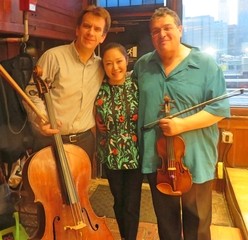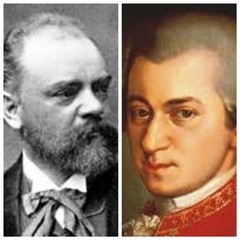|
Back
The Music of Joy New York
BargeMusic
09/14/2019 - & September 15, 2019
Antonín Dvorák: Piano Trio No. 4 “Dumky”, Opus 90
Wolfgang Amadeus Mozart: Piano Trio in E Major, K. 542
Jeewon Park (Piano), Mark Peskanov (Violin), Edward Arron (Cello)

E. Arron, J. Park, M. Peskanov (© Samuel A. Dog)
“In both Schubert and Mozart, we find the same delicate sense of instrumental coloring, the same spontaneous and irrepressible flow of melody, the same instinctive command of the means of expression...”
Antonín Dvorák (1841-1904)
"When are we to have a little musical party at your house again?” asked the ebullient Wolfgang Amadeus Mozart, while composing his 39th Symphony in the summer of 1788. “I have composed a new trio!”
Mozart referred to his E Major Trio with typical insouciance. Whatever the depth of his final three symphonies or The Magic Flute, all composed in the same year, his K. 542 was to be a lighthearted work, supposedly a 23-minute bagatelle. And of course a masterpiece.
Listening to BargeMusic director Mark Peskanov, piano soloist Jeewon Park and cellist Edward Arron play this Trio last night at BargeMusic, one understood how feather-light this work could be. Those hearing it for the first time might imagine the Trio so simple it could have been written by the teenage Mozart. But no, when three superb soloists come together (in a kind of public party!), one realizes that this is the distillation of simplicity, the inversion of naďveté.
Initially, one must acknowledge that the usual definition of chamber music as “a discourse among friends” is usually a metaphor. In last night’s case, Mr. Peskanov–the Director and Artistic Director of BargeMusic–has worked with the two other soloists countless times, and his 3,000-odd concerts at BargeMusic has made him not only a splendid fiddler but an iconic “friend” to his musicians. Add to this the marriage–not only musically but spousally–between Ms. Park and Mr. Arron–offering another dimension to the music.
Thus, the initial entrance of violin and cello over Ms. Park’s wondrous piano, seemed inevitable. The lightness was actually less feather-lightness than a buoyancy. Mr. Arron barely looked at the score. His eyes were on Mr. Peskanov, not for cueing but for assurance of nuance. Mozart had wrestled with his symphonies. For the Trio, he simply let the melodies flow from his pen.
Trios at this time were mainly for piano, with a few string interruptions. Here, he gave violin and cello major parts. But, since he was to play the piano part himself, that instrument was technically virtuosic. I had missed Ms. Park in her recital the night before, but here, she allowed all the grandiosity which such chamber music deserved.
Yet it was the Andante grazioso which was strangest. One cannot imagine a more banal, more threadworn theme for the rondo, repeated again and again by Ms. Park. Thus, Messrs Arron and Peskanov had to vary their own colors, to change keys, work from major to minor for its surprise effect.
One didn’t have to worry about banality in the finale. The piano triplets (one wanted to snap fingers) was set for a virtually symphonic (or at least concertante) invention of the finale. Variations of Mr. Peskanov’s spiccato bouncing bow with strong lines by Mr. Arron were both intriguing and ingenious.
In other words, it was W.A. Mozart.

A. Dvorák/W. A. Mozart
The Dvorák Fourth Trio was such a neat contrast to the Mozart that Mr. Arron had to give an introduction, speaking about the Ukrainian dumky songs. Specifically, that dumky is a plural: Dvorák used the dumka in many different forms.
Thus, the difference. Mozart’s inventions were numerous–but they all fit into the bouncing happiness of the work. Dvorák had equally different creations– but they were each singular, they hardly ever coalesced even within the same movement.
In a way, these non-Czech songs were morphed (or transcribed) inevitably into a Dvorák thesaurus. We had Brahms-style gypsy dances (not Hungarian dances), melancholy chansons, reflections, we had gorgeous ensemble playing, equally gorgeous solo playing (Mr. Peskanov’s high solos in the Allegro movement) and–above all–sudden, almost jarring changes in tempo.
For some reason, the players left space between the first three movements, and most scores call them Attaca (played together). But no problem here. Dvorák’s Trio had so many abrupt changes that a pause was perhaps necessary.
Nor could one worry about the tempo changes. Too fast or too slow, to hesitant the piano arpeggios or too forceful the fortissimo passages would be petty comments.
In a way, Dvorák, breaking loose from his Viennese/Brahmsian influence, let himself go a bit wild here. Perhaps saying to himself, “Well, yes, I guess structure is fundamental. But hey! I’m a Czech! I’ll do what the hell I want. I won’t even give a tempo for the last movement. Let the players decide what they want to do.”
In fact, both Mozart and Dvorák invented last night’s selections with pure delight. Such joy was produced by three consummate artists and reflected in the infectious joy of the BargeMusic audience.
Harry Rolnick
|